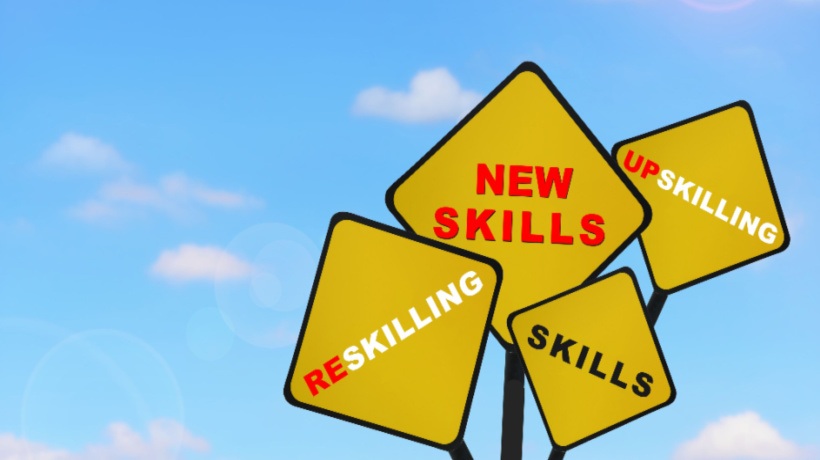Looking Under The Hood Of What We Mean By Employee Skilling
In my previous article, I had outlined how an organization needs to ensure that the content that is on offer from their learning partner needs to have a low-stake test at the end of each course. I want to build on that thought and bring in some more nuances in this piece. If you were to read any business magazine, journal, or attend a conference today, there would be one word that you would hear thrown around a lot, and that word is skilling. Given the market forces of today, the emphasis on upskilling and reskilling is justified. Therefore, I do not want to get into why one should brush up on one’s skills. I would rather focus on how this needs to be done.
To do that, let me get to the workplace of the present world. Most of us today are part of the knowledge economy. (Please refer to my previous article on the knowledge worker.) This means that the kind of work we perform calls for complex skills. A complex skill can be thought of as a skill that consists of many elements that interact with each other. Learning experts Paul Kirschner and Jeroen van Merrienboer say that a complex skill can be decomposed into smaller constituent skills which are subskills and their interrelationship. It is these complex skills that need to be kept up to date by learners.
Since most of us have not yet returned to offices completely, learning here refers to eLearning or learning over the web.
Knowledge Skill Attitude (KSA)
We need to get a little deeper into what we mean by learning so that we understand how we can help learners reskill and upskill. Learning consists of 3 domains:
- Cognitive
This refers to mental skills or the knowledge aspect. - Affective
This is the emotional component in a person or the attitude aspect. - Psychomotor
This is manual or physical skills.
It is the cognitive domain that usually gets most of the attention from L&D organizations and training companies. This domain can be further divided into:
- Declarative knowledge, which consists of facts, principles, concepts, etc. This addresses the "know-what" or what is traditionally understood as knowledge.
- Procedural knowledge, that is the "know-how" part. Here one would talk of best practices, etc. This is classified under what we generally call "skills." (This, however, is a category error. Procedural knowledge does not equal skill, but we will leave that for another discussion.)
The affective domain or the attitude component also plays an important part in skill acquisition. Here, “the learner moves from being aware of what they are learning to a stage of having internalized the learning so that it plays a role in guiding their actions,” according to O’Neill and Murphy. The learner’s attitude to the newly acquired or improved learning area will influence how that will be translated to the workplace.
Complex learning involves integrating all three domains—knowledge, skill, and attitude—and the transfer of that learning to the workplace. We must remember that focusing on any one domain at the cost of excluding the other two will not help the cause of the knowledge worker. We must also keep in mind that it is not enough for learners to acquire learning. This learning also needs to be transferred to the workplace. This transfer of the newly learned or updated skill needs to be visible at the workplace in the form of a better, faster, or different way of performance, which was the reason for learners adopting the learning intervention in the first place, resulting in upskilling or reskilling.
It must be understood that the improved performance in many cases may not be immediately visible, especially when the learning is being pursued to fulfill an aspirational need; for example, a business analyst aspiring to become a data scientist. In this case, the performance would not be seen immediately but would only be visible sometime in the future when the learner actually becomes a data scientist.
Having said this, we must also consider that the attitude of the business analyst in their current role will now be influenced by their learning. The aspiration of becoming a data scientist would spur them into being better performers in their current role as they upskill themselves to becoming data scientists.
So how exactly do learners upskill or reskill themselves?
High-Quality Content
The first thing that learners need is high-quality content from an authorized source. This means that the content that your learning partner has needs to be built on scientific research and one that adheres to adult learning principles. (This was alluded to in my previous article. Therefore, I will not get into details here.) Learners are able to consume this content which caters to the cognitive domain of learning. Learners are now in possession of a new or improved area of knowledge.
It is not enough to cater to the cognitive domain of learning. While factual and procedural knowledge is important and necessary, it must be kept in mind that learners need to apply this newfound knowledge to their current job situation. This should result in an observable improvement of their skills over a period.
Learner Engagement
To paraphrase from the book Evidence-Informed Learning Design by Mirjam Neelan and Paul Kirschner, for effective transfer to take place, learners need to participate in the learning process. Without this, there is no deep conceptual understanding of what has been learned. This is where the engagement of learners with the learning content and the platform that learning resides on comes into play. Now you can see that it is not enough to have great content, but the learning experience of learners also matters.
Learning experience is a vast subject, and I will restrict myself to just mentioning that learners need to have a pleasant user experience with both the learning content as well as the learning platform. This is an important aspect to be kept in mind, as we need learners to be sufficiently motivated in the learning process so that effective learning takes place. Since we are referring to complex skills, we can be sure this calls for hard work overtime. It also means that the whole experience of learning for learners needs to be an enjoyable one. A word of caution here: Enjoyable does not mean making learning fun, although that would be a nice by-product to have. What I mean by enjoyable learning is that learning is not a tedious exercise that needs to be completed so that a box can be checked off. Learners who have a good learning experience will be willing to come back for more learning.
Learning Transfer
For an effective transfer to take place, learners need to have an environment where all or some of the following need to be present:
- Opportunity to reflect on the learning. This would include pausing to think and relive the learning experience
- Conversation or discussion with others on what has been learned
- Self-explaining, writing, or summarizing the learning
- Teaching others or passing on what has been learned to another person
And more:
Learning transfer also needs a thriving performance support system which would include scaffolding and an electronic performance support system (EPSS). Here learners get the required support to help them transfer the updated learning to the workplace. We all know that it is hard for people to learn and sustain new habits. Given that most of us are working from home, we do not have the luxury of seeking help from the person sitting next to us. This makes it all the more important for adequate support to be provided to learners so that the transfer of learning can take place.
We all know that for an organization to be competitive today it must have access to adequate financial capital, a good product, and a capable well-trained workforce. Of the three, what will give them the real edge in the marketplace is a better trained and motivated workforce. Therefore, skilling is essential, but a careful consideration also needs to be made when it comes to making a choice of one's learner partner because there is a lot that is riding on that decision.
Thus, it can be seen that when it comes to skilling, all three domains, knowledge, skill, and attitude, would need to be catered to. It is not enough for learners to increase their knowledge; this also needs to be translated into performance.
Sources:
- Evidence-Informed Learning Design, Mirjam Neelan & Paul A Kirschner, Kogan Page (2020)
- Guide To Taxonomies of Learning, Geraldine O'Neal & Feargal Murphy (2010)









